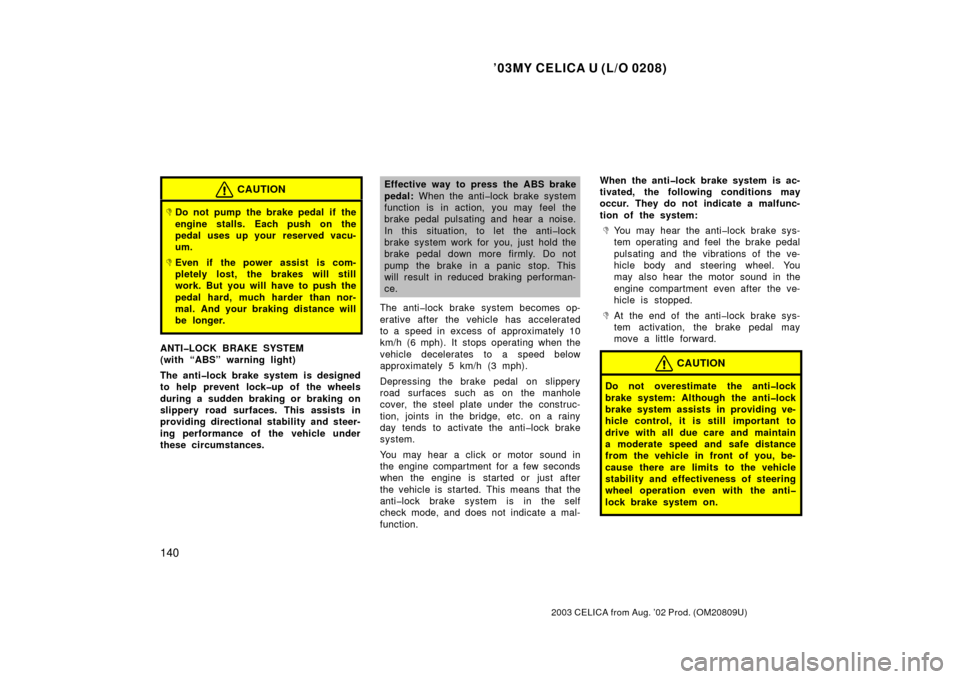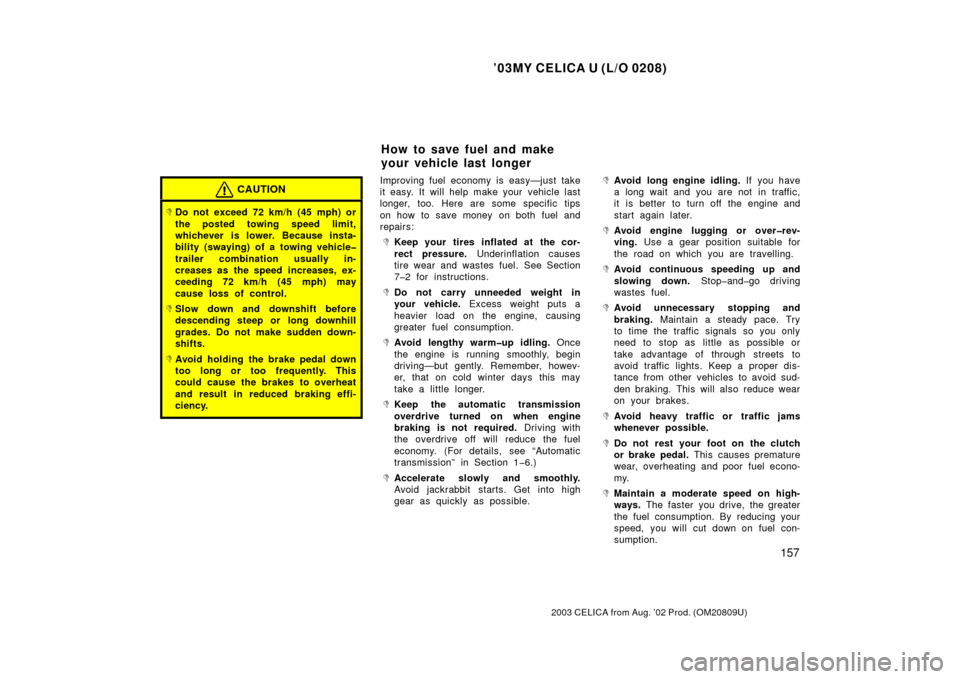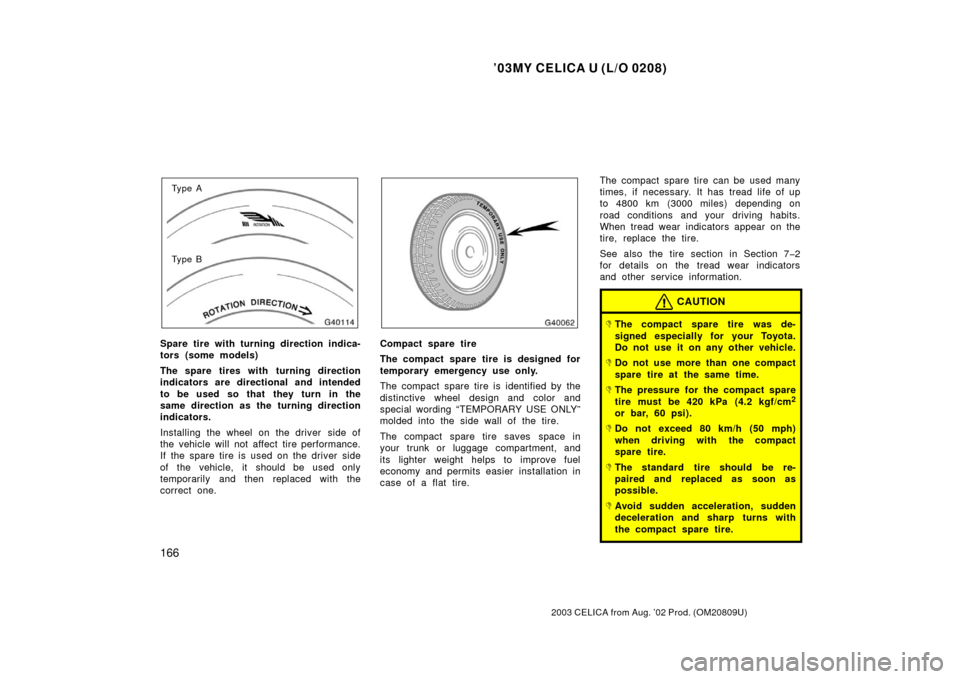Page 144 of 249

’03MY CELICA U (L/O 0208)
140
2003 CELICA from Aug. ’02 Prod. (OM20809U)
CAUTION
�Do not pump the brake pedal if the
engine stalls. Each push on the
pedal uses up your reserved vacu-
um.
�Even if the power assist is com-
pletely lost, the brakes will still
work. But you will have to push the
pedal hard, much harder than nor-
mal. And your braking distance will
be longer.
ANTI�LOCK BRAKE SYSTEM
(with “ABS” warning light)
The anti�lock brake system is designed
to help prevent lock�up of the wheels
during a sudden braking or braking on
slippery road surfaces. This assists in
providing directional stability and steer-
ing performance of the vehicle under
these circumstances.
Effective way to press the ABS brake
pedal: When the anti�lock brake system
function is in action, you may feel the
brake pedal pulsating and hear a noise.
In this situation, to let the anti�lock
brake system work for you, just hold the
brake pedal down more firmly. Do not
pump the brake in a panic stop. This
will result in reduced braking performan-
ce.
The anti�lock brake system becomes op-
erative after the vehicle has accelerated
to a speed in excess of approximately 10
km/h (6 mph). It stops operating when the
vehicle decelerates to a speed below
approximately 5 km/h (3 mph).
Depressing the brake pedal on slippery
road surfaces such as on the manhole
cover, the steel plate under the construc-
tion, joints in the bridge, etc. on a rainy
day tends to activate the anti�lock brake
system.
You may hear a click or motor sound in
the engine compartment for a few seconds
when the engine is started or just after
the vehicle is started. This means that the
anti�lock brake system is in the self
check mode, and does not indicate a mal-
function. When the anti�lock brake system is ac-
tivated, the following conditions may
occur. They do not indicate a malfunc-
tion of the system:
�You may hear the anti�lock brake sys-
tem operating and feel the brake pedal
pulsating and the vibrations of the ve-
hicle body and steering wheel. You
may also hear the motor sound in the
engine compartment even after the ve-
hicle is stopped.
�At the end of the anti�lock brake sys-
tem activation, the brake pedal may
move a little forward.
CAUTION
Do not overestimate the anti�lock
brake system: Although the anti�lock
brake system assists in providing ve-
hicle control, it is still important to
drive with all due care and maintain
a moderate speed and safe distance
from the vehicle in front of you, be-
cause there are limits to the vehicle
stability and effectiveness of steering
wheel operation even with the anti�
lock brake system on.
Page 161 of 249

’03MY CELICA U (L/O 0208)
157
2003 CELICA from Aug. ’02 Prod. (OM20809U)
CAUTION
�Do not exceed 72 km/h (45 mph) or
the posted towing speed limit,
whichever is lower. Because insta-
bility (swaying) of a towing vehicle�
trailer combination usually in-
creases as the speed increases, ex-
ceeding 72 km/h (45 mph) may
cause loss of control.
�Slow down and downshift before
descending steep or long downhill
grades. Do not make sudden down-
shifts.
�Avoid holding the brake pedal down
too long or too frequently. This
could cause the brakes to overheat
and result in reduced braking effi-
ciency.
Improving fuel economy is easy—just take
it easy. It will help make your vehicle last
longer, too. Here are some specific tips
on how to save money on both fuel and
repairs:
�Keep your tires inflated at the cor-
rect pressure. Underinflation causes
tire wear and wastes fuel. See Section
7�2 for instructions.
�Do not carry unneeded weight in
your vehicle. Excess weight puts a
heavier load on the engine, causing
greater fuel consumption.
�Avoid lengthy warm�up idling. Once
the engine is running smoothly, begin
driving—but gently. Remember, howev-
er, that on cold winter days this may
take a little longer.
�Keep the automatic transmission
overdrive turned on when engine
braking is not required. Driving with
the overdrive off will reduce the fuel
economy. (For details, see “Automatic
transmission” in Section 1�6.)
�Accelerate slowly and smoothly.
Avoid jackrabbit starts. Get into high
gear as quickly as possible.
�Avoid long engine idling. If you have
a long wait and you are not in traffic,
it is better to turn off the engine and
start again later.
�Avoid engine lugging or over�rev-
ving. Use a gear position suitable for
the road on which you are travelling.
�Avoid continuous speeding up and
slowing down. Stop�and�go driving
wastes fuel.
�Avoid unnecessary stopping and
braking. Maintain a steady pace. Try
to time the traffic signals so you only
need to stop as little as possible or
take advantage of through streets to
avoid traffic lights. Keep a proper dis-
tance from other vehicles to avoid sud-
den braking. This will also reduce wear
on your brakes.
�Avoid heavy traffic or traffic jams
whenever possible.
�Do not rest your foot on the clutch
or brake pedal. This causes premature
wear, overheating and poor fuel econo-
my.
�Maintain a moderate speed on high-
ways. The faster you drive, the greater
the fuel consumption. By reducing your
speed, you will cut down on fuel con-
sumption.
How to save fuel and make
your vehicle last longer
Page 170 of 249

’03MY CELICA U (L/O 0208)
166
2003 CELICA from Aug. ’02 Prod. (OM20809U)
Ty p e A
Ty p e B
Spare tire with turning direction indica-
tors (some models)
The spare tires with turning direction
indicators are directional and intended
to be used so that they turn in the
same direction as the turning direction
indicators.
Installing the wheel on the driver side of
the vehicle will not affect tire performance.
If the spare tire is used on the driver side
of the vehicle, it should be used only
temporarily and then replaced with the
correct one.Compact spare tire
The compact spare tire is designed for
temporary emergency use only.
The compact spare tire is identified by the
distinctive wheel design and color and
special wording “TEMPORARY USE ONLY”
molded into the side wall of the tire.
The compact spare tire saves space in
your trunk or luggage compartment, and
its lighter weight helps to improve fuel
economy and permits easier installation in
case of a flat tire. The compact spare tire can be used many
times, if necessary. It has tread life of up
to 4800 km (3000 miles) depending on
road conditions and your driving habits.
When tread wear indicators appear on the
tire, replace the tire.
See also the tire section in Section 7�2
for details on the tread wear indicators
and other service information.
CAUTION
�The compact spare tire was de-
signed especially for your Toyota.
Do not use it on any other vehicle.
�Do not use more than one compact
spare tire at the same time.
�The pressure for the compact spare
tire must be 420 kPa (4.2 kgf/cm2
or bar, 60 psi).
�Do not exceed 80 km/h (50 mph)
when driving with the compact
spare tire.
�The standard tire should be re-
paired and replaced as soon as
possible.
�Avoid sudden acceleration, sudden
deceleration and sharp turns with
the compact spare tire.